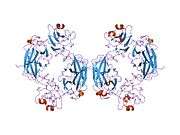EFNB2
Ephrin-B2 is a protein that in humans is encoded by the EFNB2 gene.[1]
Function
This gene encodes a member of the ephrin (EPH) family. The ephrins and EPH-related receptors comprise the largest subfamily of receptor protein-tyrosine kinases and have been implicated in mediating developmental events, especially in the nervous system and in erythropoiesis. Based on their structures and sequence relationships, ephrins are divided into the ephrin-A (EFNA) class, which are anchored to the membrane by a glycosylphosphatidylinositol linkage, and the ephrin-B (EFNB) class, which are transmembrane proteins. This gene encodes an EFNB class ephrin which binds to the EPHB4 and EPHA3 receptors.[2]
Interactions
EFNB2 has been shown to interact with EPHA3.[3][4]
References
- ↑ Bonaldo MF, Yu MT, Jelenc P, Brown S, Su L, Lawton L, Deaven L, Efstratiadis A, Warburton D, Soares MB (Sep 1994). "Selection of cDNAs using chromosome-specific genomic clones: application to human chromosome 13". Human Molecular Genetics 3 (9): 1663–73. doi:10.1093/hmg/3.9.1663. PMID 7833926.
- ↑ "Entrez Gene: EFNB2 ephrin-B2".
- ↑ Cerretti DP, Vanden Bos T, Nelson N, Kozlosky CJ, Reddy P, Maraskovsky E, Park LS, Lyman SD, Copeland NG, Gilbert DJ (Nov 1995). "Isolation of LERK-5: a ligand of the eph-related receptor tyrosine kinases". Molecular Immunology 32 (16): 1197–205. doi:10.1016/0161-5890(95)00108-5. PMID 8559144.
- ↑ Lackmann M, Mann RJ, Kravets L, Smith FM, Bucci TA, Maxwell KF, Howlett GJ, Olsson JE, Vanden Bos T, Cerretti DP, Boyd AW (Jun 1997). "Ligand for EPH-related kinase (LERK) 7 is the preferred high affinity ligand for the HEK receptor". The Journal of Biological Chemistry 272 (26): 16521–30. doi:10.1074/jbc.272.26.16521. PMID 9195962.
Further reading
- Flanagan JG, Vanderhaeghen P (1998). "The ephrins and Eph receptors in neural development". Annual Review of Neuroscience 21: 309–45. doi:10.1146/annurev.neuro.21.1.309. PMID 9530499.
- Zhou R (Mar 1998). "The Eph family receptors and ligands". Pharmacology & Therapeutics 77 (3): 151–81. doi:10.1016/S0163-7258(97)00112-5. PMID 9576626.
- Holder N, Klein R (May 1999). "Eph receptors and ephrins: effectors of morphogenesis". Development 126 (10): 2033–44. PMID 10207129.
- Wilkinson, David G. (2000). "Eph receptors and ephrins: Regulators of guidance and assembly" 196: 177–244. doi:10.1016/S0074-7696(00)96005-4. ISSN 0074-7696.
- Xu Q, Mellitzer G, Wilkinson DG (Jul 2000). "Roles of Eph receptors and ephrins in segmental patterning". Philosophical Transactions of the Royal Society of London. Series B, Biological Sciences 355 (1399): 993–1002. doi:10.1098/rstb.2000.0635. PMC 1692797. PMID 11128993.
- Wilkinson DG (Mar 2001). "Multiple roles of EPH receptors and ephrins in neural development". Nature Reviews. Neuroscience 2 (3): 155–64. doi:10.1038/35058515. PMID 11256076.
- Bennett BD, Zeigler FC, Gu Q, Fendly B, Goddard AD, Gillett N, Matthews W (Mar 1995). "Molecular cloning of a ligand for the EPH-related receptor protein-tyrosine kinase Htk". Proceedings of the National Academy of Sciences of the United States of America 92 (6): 1866–70. doi:10.1073/pnas.92.6.1866. PMC 42383. PMID 7534404.
- Cerretti DP, Vanden Bos T, Nelson N, Kozlosky CJ, Reddy P, Maraskovsky E, Park LS, Lyman SD, Copeland NG, Gilbert DJ (Nov 1995). "Isolation of LERK-5: a ligand of the eph-related receptor tyrosine kinases". Molecular Immunology 32 (16): 1197–205. doi:10.1016/0161-5890(95)00108-5. PMID 8559144.
- Cerretti DP, Lyman SD, Kozlosky CJ, Copeland NG, Gilbert DJ, Jenkins NA, Valentine V, Kirstein MN, Shapiro DN, Morris SW (Apr 1996). "The genes encoding the eph-related receptor tyrosine kinase ligands LERK-1 (EPLG1, Epl1), LERK-3 (EPLG3, Epl3), and LERK-4 (EPLG4, Epl4) are clustered on human chromosome 1 and mouse chromosome 3". Genomics 33 (2): 277–82. doi:10.1006/geno.1996.0192. PMID 8660976.
- Gale NW, Holland SJ, Valenzuela DM, Flenniken A, Pan L, Ryan TE, Henkemeyer M, Strebhardt K, Hirai H, Wilkinson DG, Pawson T, Davis S, Yancopoulos GD (Jul 1996). "Eph receptors and ligands comprise two major specificity subclasses and are reciprocally compartmentalized during embryogenesis". Neuron 17 (1): 9–19. doi:10.1016/S0896-6273(00)80276-7. PMID 8755474.
- Holland SJ, Gale NW, Mbamalu G, Yancopoulos GD, Henkemeyer M, Pawson T (Oct 1996). "Bidirectional signalling through the EPH-family receptor Nuk and its transmembrane ligands". Nature 383 (6602): 722–5. doi:10.1038/383722a0. PMID 8878483.
- Ephnomenclaturecommittee (Aug 1997). "Unified nomenclature for Eph family receptors and their ligands, the ephrins. Eph Nomenclature Committee". Cell 90 (3): 403–4. doi:10.1016/S0092-8674(00)80500-0. PMID 9267020.
- Vogt T, Stolz W, Welsh J, Jung B, Kerbel RS, Kobayashi H, Landthaler M, McClelland M (Mar 1998). "Overexpression of Lerk-5/Eplg5 messenger RNA: a novel marker for increased tumorigenicity and metastatic potential in human malignant melanomas". Clinical Cancer Research 4 (3): 791–7. PMID 9533549.
- Wang HU, Chen ZF, Anderson DJ (May 1998). "Molecular distinction and angiogenic interaction between embryonic arteries and veins revealed by ephrin-B2 and its receptor Eph-B4". Cell 93 (5): 741–53. doi:10.1016/S0092-8674(00)81436-1. PMID 9630219.
- Nikolova Z, Djonov V, Zuercher G, Andres AC, Ziemiecki A (Sep 1998). "Cell-type specific and estrogen dependent expression of the receptor tyrosine kinase EphB4 and its ligand ephrin-B2 during mammary gland morphogenesis". Journal of Cell Science. 111 ( Pt 18) (18): 2741–51. PMID 9718367.
- Torres R, Firestein BL, Dong H, Staudinger J, Olson EN, Huganir RL, Bredt DS, Gale NW, Yancopoulos GD (Dec 1998). "PDZ proteins bind, cluster, and synaptically colocalize with Eph receptors and their ephrin ligands". Neuron 21 (6): 1453–63. doi:10.1016/S0896-6273(00)80663-7. PMID 9883737.
- Lin D, Gish GD, Songyang Z, Pawson T (Feb 1999). "The carboxyl terminus of B class ephrins constitutes a PDZ domain binding motif". The Journal of Biological Chemistry 274 (6): 3726–33. doi:10.1074/jbc.274.6.3726. PMID 9920925.
| |||||||||||||
| ||||||||||||||||||
This article is issued from Wikipedia - version of the Saturday, November 14, 2015. The text is available under the Creative Commons Attribution/Share Alike but additional terms may apply for the media files.





